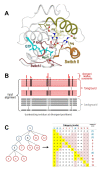Bayesian classification of residues associated with protein functional divergence: Arf and Arf-like GTPases
- PMID: 21129209
- PMCID: PMC3012027
- DOI: 10.1186/1745-6150-5-66
Bayesian classification of residues associated with protein functional divergence: Arf and Arf-like GTPases
Abstract
Background: Certain residues within proteins are highly conserved across very distantly related organisms, yet their (presumably critical) structural or mechanistic roles are completely unknown. To obtain clues regarding such residues within Arf and Arf-like (Arf/Arl) GTPases--which function as on/off switches regulating vesicle trafficking, phospholipid metabolism and cytoskeletal remodeling--I apply a new sampling procedure for comparative sequence analysis, termed multiple category Bayesian Partitioning with Pattern Selection (mcBPPS).
Results: The mcBPPS sampler classified sequences within the entire P-loop GTPase class into multiple categories by identifying those evolutionarily-divergent residues most likely to be responsible for functional specialization. Here I focus on categories of residues that most distinguish various Arf/Arl GTPases from other GTPases. This identified residues whose specific roles have been previously proposed (and in some cases corroborated experimentally and that thus serve as positive controls), as well as several categories of co-conserved residues whose possible roles are first hinted at here. For example, Arf/Arl/Sar GTPases are most distinguished from other GTPases by a conserved aspartate residue within the phosphate binding loop (P-loop) and by co-conserved residues nearby that, together, can form a network of salt-bridge and hydrogen bond interactions centered on the GTPase active site. Residues corresponding to an N-[VI] motif that is conserved within Arf/Arl GTPases may play a role in the interswitch toggle characteristic of the Arf family, whereas other, co-conserved residues may modulate the flexibility of the guanine binding loop. Arl8 GTPases conserve residues that strikingly diverge from those typically found in other Arf/Arl GTPases and that form structural interactions suggestive of a novel interswitch toggle mechanism.
Conclusions: This analysis suggests specific mutagenesis experiments to explore mechanisms underlying GTP hydrolysis, nucleotide exchange and interswitch toggling within Arf/Arl GTPases. More generally, it illustrates how the mcBPPS sampler can complement traditional evolutionary analyses by providing an objective, quantitative and statistically rigorous way to explore protein functional-divergence in molecular detail. Because the sampler classifies the input sequences at the same time, it can be used to generate subgroup profiles, in which functionally-divergent categories of residues are annotated automatically.
Figures





Similar articles
-
Arf, Arl, Arp and Sar proteins: a family of GTP-binding proteins with a structural device for 'front-back' communication.EMBO Rep. 2002 Nov;3(11):1035-41. doi: 10.1093/embo-reports/kvf221. EMBO Rep. 2002. PMID: 12429613 Free PMC article.
-
Structural and biochemical properties show ARL3-GDP as a distinct GTP binding protein.Structure. 2000 Dec 15;8(12):1239-45. doi: 10.1016/s0969-2126(00)00531-1. Structure. 2000. PMID: 11188688
-
Localization and function of Arf family GTPases.Biochem Soc Trans. 2005 Aug;33(Pt 4):639-42. doi: 10.1042/BST0330639. Biochem Soc Trans. 2005. PMID: 16042562 Review.
-
Arf-like GTPases: not so Arf-like after all.Trends Cell Biol. 2004 Dec;14(12):687-94. doi: 10.1016/j.tcb.2004.10.004. Trends Cell Biol. 2004. PMID: 15564045 Review.
-
The glycine brace: a component of Rab, Rho, and Ran GTPases associated with hinge regions of guanine- and phosphate-binding loops.BMC Struct Biol. 2009 Mar 5;9:11. doi: 10.1186/1472-6807-9-11. BMC Struct Biol. 2009. PMID: 19265520 Free PMC article.
Cited by
-
Coupled regulation by the juxtamembrane and sterile α motif (SAM) linker is a hallmark of ephrin tyrosine kinase evolution.J Biol Chem. 2018 Apr 6;293(14):5102-5116. doi: 10.1074/jbc.RA117.001296. Epub 2018 Feb 12. J Biol Chem. 2018. PMID: 29432127 Free PMC article.
-
Surveying the manifold divergence of an entire protein class for statistical clues to underlying biochemical mechanisms.Stat Appl Genet Mol Biol. 2011;10(1):Article 36. doi: 10.2202/1544-6115.1666. Epub 2011 Aug 4. Stat Appl Genet Mol Biol. 2011. PMID: 22331370 Free PMC article.
-
Automated hierarchical classification of protein domain subfamilies based on functionally-divergent residue signatures.BMC Bioinformatics. 2012 Jun 22;13:144. doi: 10.1186/1471-2105-13-144. BMC Bioinformatics. 2012. PMID: 22726767 Free PMC article.
-
Tribbles in the 21st Century: The Evolving Roles of Tribbles Pseudokinases in Biology and Disease.Trends Cell Biol. 2017 Apr;27(4):284-298. doi: 10.1016/j.tcb.2016.11.002. Epub 2016 Nov 28. Trends Cell Biol. 2017. PMID: 27908682 Free PMC article. Review.
-
Discovery of Novel DENN Proteins: Implications for the Evolution of Eukaryotic Intracellular Membrane Structures and Human Disease.Front Genet. 2012 Dec 13;3:283. doi: 10.3389/fgene.2012.00283. eCollection 2012. Front Genet. 2012. PMID: 23248642 Free PMC article.
References
-
- Wittinghofer A. In: GTPases. Hall A, editor. Oxford: Oxford University Press; 2000. The Functioning of Molecular Switches in Three Dimensions; pp. 244–310.
Publication types
MeSH terms
Substances
Grants and funding
LinkOut - more resources
Full Text Sources
Molecular Biology Databases
Miscellaneous

